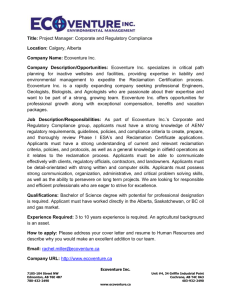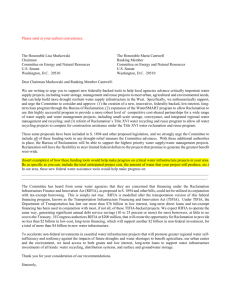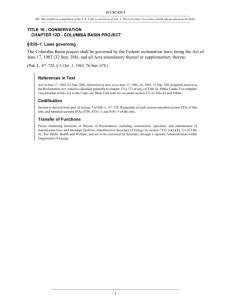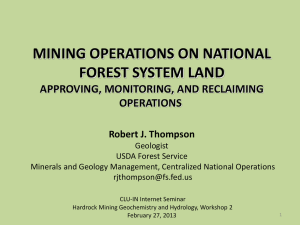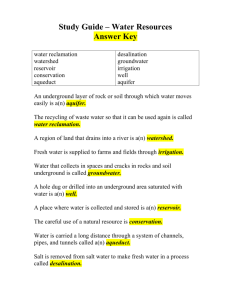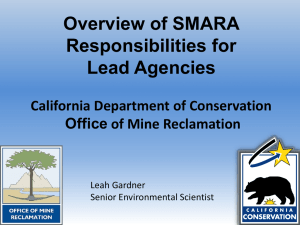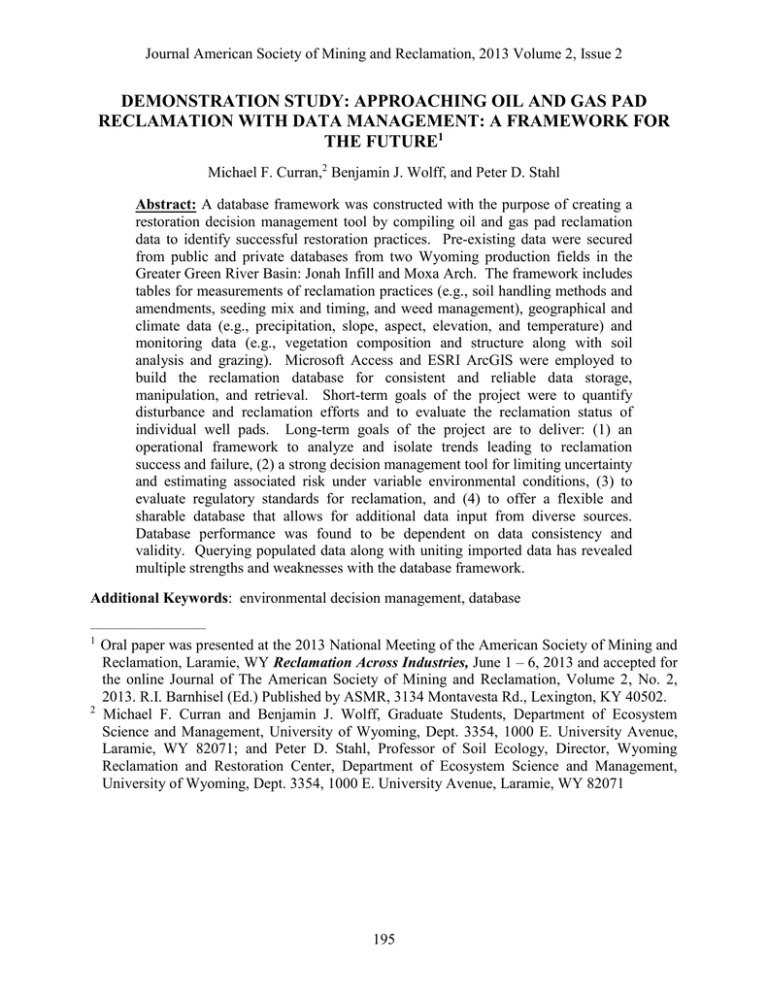
Journal American Society of Mining and Reclamation, 2013 Volume 2, Issue 2
DEMONSTRATION STUDY: APPROACHING OIL AND GAS PAD
RECLAMATION WITH DATA MANAGEMENT: A FRAMEWORK FOR
THE FUTURE1
Michael F. Curran,2 Benjamin J. Wolff, and Peter D. Stahl
Abstract: A database framework was constructed with the purpose of creating a
restoration decision management tool by compiling oil and gas pad reclamation
data to identify successful restoration practices. Pre-existing data were secured
from public and private databases from two Wyoming production fields in the
Greater Green River Basin: Jonah Infill and Moxa Arch. The framework includes
tables for measurements of reclamation practices (e.g., soil handling methods and
amendments, seeding mix and timing, and weed management), geographical and
climate data (e.g., precipitation, slope, aspect, elevation, and temperature) and
monitoring data (e.g., vegetation composition and structure along with soil
analysis and grazing). Microsoft Access and ESRI ArcGIS were employed to
build the reclamation database for consistent and reliable data storage,
manipulation, and retrieval. Short-term goals of the project were to quantify
disturbance and reclamation efforts and to evaluate the reclamation status of
individual well pads. Long-term goals of the project are to deliver: (1) an
operational framework to analyze and isolate trends leading to reclamation
success and failure, (2) a strong decision management tool for limiting uncertainty
and estimating associated risk under variable environmental conditions, (3) to
evaluate regulatory standards for reclamation, and (4) to offer a flexible and
sharable database that allows for additional data input from diverse sources.
Database performance was found to be dependent on data consistency and
validity. Querying populated data along with uniting imported data has revealed
multiple strengths and weaknesses with the database framework.
Additional Keywords: environmental decision management, database
_______________________
1
2
Oral paper was presented at the 2013 National Meeting of the American Society of Mining and
Reclamation, Laramie, WY Reclamation Across Industries, June 1 – 6, 2013 and accepted for
the online Journal of The American Society of Mining and Reclamation, Volume 2, No. 2,
2013. R.I. Barnhisel (Ed.) Published by ASMR, 3134 Montavesta Rd., Lexington, KY 40502.
Michael F. Curran and Benjamin J. Wolff, Graduate Students, Department of Ecosystem
Science and Management, University of Wyoming, Dept. 3354, 1000 E. University Avenue,
Laramie, WY 82071; and Peter D. Stahl, Professor of Soil Ecology, Director, Wyoming
Reclamation and Restoration Center, Department of Ecosystem Science and Management,
University of Wyoming, Dept. 3354, 1000 E. University Avenue, Laramie, WY 82071
195
Journal American Society of Mining and Reclamation, 2013 Volume 2, Issue 2
Introduction
The amount of proven recoverable natural gas below the surface of Wyoming is 36.75 trillion
cu ft, leaving Texas as the only state in the US with more subsurface, recoverable gas (PAW
2012). The large amount of gas available in Wyoming has helped economic growth in the state
and has resulted in an average of 41% annual growth in new wells throughout the state since
1998, a trend expected to continue in the near future (Anderson and Coupal, 2009).
As
production fields continue to grow, surface land disturbance will continue to increase.
As the amount of land being disturbed by oil and gas drilling increases, land-use values
(grazing and wildlife habitat) and watershed protection provided by the natural landscape may
decline. Many areas where oil and natural gas are extracted in Wyoming are considered critical
habitat areas for wildlife species such as sage grouse, mule deer, antelope, and elk.
The
continuance of these species depends heavily on vegetation provided in their habitat and,
therefore, it is essential for vegetative restoration processes to be well understood (Holechek,
2006, Winslow et al., 2009). Natural resource development may be curtailed in the future if
wildlife habitat and ecological degradation is not mitigated with positive and effective
reclamation practices (Stahl and Williams, 2010). While there have been many isolated studies
to examine seeding and soil handling practices on oil and gas pads, there is much lacking in
terms of understanding large-scale restoration efforts of industry practitioners (Hild et al., 2009).
For this reason, a database framework has been created to house oil and natural gas pad
reclamation data from public and private sources over a large scale. The database currently
holds disturbance and reclamation information over eight years (2005-2012) of BP America
Production Company (BP) well pads from two Wyoming production fields in the Greater Green
River Basin: Jonah Infill and Moxa Arch. Keeping in mind the end goal of this project, this
database was designed as an operational framework to analyze and isolate trends leading to
reclamation success and failure and can serve as a decision management tool for future
reclamation projects. In addition, flexibility, sharebility, and scalability were key ingredients
from the initial design, allowing for data input from diverse sources. The objective of this paper
is to outline the construction and design processes of the database framework and provide
examples of how the database can be implemented.
196
Journal American Society of Mining and Reclamation, 2013 Volume 2, Issue 2
Methods
Reclamation data were secured from public and private databases across two Wyoming
production fields: Jonah Infill and Moxa Arch in the Greater Green River Basin. Both areas are
comprised of sagebrush-steppe habitat, are semi-arid, and experience long, cold winters.
Currently, the Jonah Infill dataset consists of 116 well-pad locations, while the Moxa Arch
dataset consists of 630 well-pad locations. Oil and gas pad reclamation practice data and soil
and vegetation monitoring data were obtained from BP, Conservation, Seeding, and Restoration,
Inc. (CSR), and the Jonah Infill Data Management System (JIDMS) over the span of eight years
(2005-2012). Historic and geographic data for each site were obtained from the Wyoming Oil
and Gas Conservation Commission (WOGCC).
Climate data, including precipitation and
temperature, were obtained from Oak Ridge National Laboratory’s (ORNL) DAYMET database.
In areas where soil surveying has been completed, data tables from Natural Resource
Conservation Service’s (NRCS) Soil DataMart and Soil Survey Geographic Database
(SSURGO) were linked to our database.
Microsoft Access and ESRI ArcGIS were employed to build the reclamation database for
consistent and reliable data storage, manipulation, and retrieval. Since Microsoft Access has a
2GB storage capacity, each production field was built with the same framework but kept in
separate databases. The framework includes tables for measurements of reclamation practices
(e.g., soil handling methods and amendments, seeding mix and timing, and weed management);
historic well-pad data (e.g., spud date, additional disturbances, and plugged and abandoned date);
geographical and climate data (e.g. precipitation, slope, aspect, elevation, and temperature); and
monitoring data (e.g., vegetation composition and structure along with soil analysis and grazing).
After completion of data input, all databases were checked for the eight characteristics of quality
data according to Hoffer, et al. (2009): data accuracy, data consistency, data uniqueness, data
completeness, data timeliness, data currency, data conformance, and referential integrity.
The final database framework consists of one master table which is linked by a one-to-many
connection to 11 child tables, three of which have look-up tables linked to them (Fig. 1).
197
Journal American Society of Mining and Reclamation, 2013 Volume 2, Issue 2
Figure 1. Database framework and relationships between tables are depicted. Notice that in the
master and all child tables, API is used as the primary key. Tables in yellow represent
monitoring tables, tables in green represent reclamation practice tables, tables in blue
are geographic tables, and tables in pink are look-up tables.
The master table contains historic well data, including the American Petroleum Institute
permit number (API) for the initial well on a pad, well operator, spud date of initial well, plugged
and abandoned date for the final operational well, latitude and longitude coordinates, elevation,
state and county, and BLM regulatory office in charge. Well pad API numbers do not change
over time, and are used as unique identifiers for each pad, serving as the primary key in the
master and all related child tables. Child tables are broken into three groups: (1) monitoring
data, (2) geographic data, and (3) reclamation methods data. Four child tables are used to
describe monitoring data: (1) one table contains quantitative vegetation cover measurements for
all well pads and their undisturbed reference sites; (2) one table contains binary data showing
whether or not sites passed WDEQ requirements; (3) one table contains binary data showing
whether or not sites passed BLM reclamation requirements; and (4) one table shows results of
any soil sampling done on well pads. Two child tables are used to provide additional geographic
data: (1) one provides slope and aspect data provided by a 10-meter resolution digital elevation
map (Gesch 2007, Gesch et al., 2002), and (2) one provides NRCS soil map units where
applicable. Five child tables were used to house reclamation practice data: (1) a seeding table
contains information about seed mix used, seed timing, and seed methodology; (2) a soil
198
Journal American Society of Mining and Reclamation, 2013 Volume 2, Issue 2
amendment table contains information about any type of soil amendment (e.g., sulfur or gypsum)
used including the rate, acreage applied to, and timing; (3) a fertilizer table contains information
about any fertilizers or compost teas including rate, acreage applied to, and timing; (4) a
disturbance table contains information about additional disturbances to wells since the
reclamation practices first initiated; and (5) an herbicide table contains information related to
herbicides sprayed on site, including herbicide used, rate, acreage applied to, and timing. The
seeding, fertilizer, and herbicide tables all have look-up tables linked to them to include specific
information to elaborate upon what is held in the child tables themselves (e.g., the seeding lookup table includes the pure live seed per acre and origin for each species included in a given seed
mix). Since the master table and child tables are linked through the API number, this database
can be considered to be a relational database with a queryable nature. This database framework
enables particular geographical, climatological, reclamation practices, or monitoring data to be
isolated or grouped together in queries in effort to identify trends leading to reclamation success
or failure.
Since the database also contains vegetation monitoring data from undisturbed
reference sites, queries can be run to compare reclamation sites to undisturbed sites or to isolate
information about reference sites in different geographical locations.
Results
Simple queries have revealed inconsistencies in monitoring methods and timing across years
in each field. For example, modified Daubenmire squares were used to monitor sites in the
Jonah Infill in 2008 and 2009, whereas in 2010 and 2011 sites were monitored using a linetransect method. In 2011, all sites in the Jonah Infill were monitored between July 6 and July 10,
whereas in 2010 most Jonah sites were monitored between June 1 and June 7.
Other simple queries have allowed us to quantify reclamation efforts in each field. For
example, in 2007, 10 well pads with a total of 60 acres (24.3 ha) of disturbance were seeded with
an early seral mix and 20 well pads with a total of 75 acres (30.3 ha) of disturbance were seeded
with a late seral mix in the Jonah Infill. Using our seeding look-up table, we are able to
determine the amount of seed per species used in each seed mix used for reclamation efforts in
the Jonah Infill (Table 1).
199
Journal American Society of Mining and Reclamation, 2013 Volume 2, Issue 2
Table 1. In 2007, two seed mixes were used in the Jonah Infill. Early Seral mix was seeded on
60 acres (24.3 ha) across 10 well pad locations, while Late Seral mix was seeded on 75
acres (30.3 ha) across 20 well pad locations. The information from our seeding lookup table allows us to rapidly find information about each seed mix.
Species Early Seral 2007
Bluebunch Wheatgrass
Needle and Thread
Western Wheat
Sandberg Bluegrass
Indian Ricegrass
Bottlebrush Squireltail
Blue flax
White Yarrow
Penstemon Strictus
PLS/Acre
2.00
3.00
3.00
0.75
3.00
1.00
1.00
0.20
0.50
Species Late Seral 2007
Gardner Saltbush
Wyoming Big Sagebrush
Rubber Rabbitbrush
Needle and Thread
Indian Ricegrass
Bluebunch Wheatgrass
Black Sage
Blue Flax
White Yarrow
Penstemon Strictus
PLS/Acre
4.00
1.00
0.50
1.00
2.50
2.00
0.40
0.75
0.20
7.15
More complex queries have revealed inconsistencies in regulatory requirements between and
amongst agencies.
In 2011, 0 of 116 sites in Jonah were considered to pass the Jonah
Interagency Office’s (JIO)reclamation criteria, while 67 sites passed the Wyoming Department
of Environmental Quality’s Storm Water Pollution Prevention Plan (SWPPP). In the Moxa
Arch, 317 of 630 sites passed Kemmerer BLM reclamation criteria, while 340 passed WDEQ
SWPPP criteria. Queries to evaluate JIO versus Kemmerer BLM standards were conducted and
revealed that all 317 sites passing Kemmerer BLM requirements in Moxa Arch would be
considered failures against JIO criteria, while 63 sites in Jonah would be considered successful
against Kemmerer BLM criteria.
Statistical analyses are currently being performed and evaluated to determine which
reclamation practices and combinations of reclamation practices are leading to the various levels
of reclamation success in given areas in wet and dry years.
Seeding, soil amendments,
fertilization, and weed management practices are being isolated by themselves and grouped with
one another before being examined alongside monitoring, geographic, and climate data in an
effort to identify best management practices. Analyses are also being performed to understand
successional patterns on reclaimed oil and natural gas pads. However, trend analysis has proven
to be difficult over the short time period our database accounts for, especially because
monitoring timing and technique vary amongst years.
200
Journal American Society of Mining and Reclamation, 2013 Volume 2, Issue 2
Discussion
The framework of this database system is sound and will allow for advancements in the field
of oil and gas pad reclamation in the future as more data are gathered over longer time periods.
The framework is flexible and sharable to allow for plenty of additional data from diverse
sources. Although this framework has strong potential to be used as a decision management tool
in the future, we have found several weaknesses in the database that need to be addressed
moving forward. Currently, the three most limiting factors to our database are: (1) the storage
capacity of Microsoft Access, (2) the minimal amount of reclamation practice data, and (3)
inconsistent monitoring data.
Since Microsoft Access is compatible with larger databases, such as SQL Server, the storage
capacity problem can be eliminated by upgrading to a larger server, at which point our databases
can be combined into a single database and allow input of mass amounts of additional data entry
from diverse sources. Currently, a multi-tiered database system is being developed to allow for
electronic forms to be used to populate the database on the front-end, while a password protected
back-end will ensure data quality and protection. The use of forms on the front-end will save
time and money associated with data entry and labor, as well as improve data accuracy by
eliminating the multiple steps that are presently being used to get data from the paper into the
database.
Combining our databases into a single database and increasing the amount of reclamation
practices being used by additional sources will allow for better understanding of best
management practices across geographic space.
By including reclamation practice and
monitoring data from additional production fields, we will also increase our understanding of
how different climates, soil types, and land forms affect reclamation success.
While this
database currently focuses solely on oil and natural gas pad reclamation, the framework allows
for reclamation data from other projects (e.g., roads, pipelines, coal mines) to be added to the
database system.
Although this database has focused on reclamation, it is capable of
incorporating wildlife data if geospatial information is available for certain individuals or
populations.
Additionally, successional trends on drastically disturbed sites will be better
understood as the temporal scale of this database system increases.
201
Journal American Society of Mining and Reclamation, 2013 Volume 2, Issue 2
More studies need to be conducted to improve monitoring techniques and timing. Without
consistent monitoring techniques and timing, our ability to perform statistical analyses and
identify best management practices is limited. Inconsistent monitoring timing is, at least in part,
due to lack of man-power and the vast spatial scale of these oil and gas fields. The Wyoming
Reclamation and Restoration Center at University of Wyoming (WRRC) is currently attempting
to develop a predictive model to aid in determining best monitoring timing to capture data during
the peak growth stage of a given growing season. This may prove beneficial for regulatory
agencies, operators, and reclamation contractors to schedule monitoring during periods best
suited to fit current regulatory criteria. It may also guide monitoring to be conducted at times
outside of peak growing season to account for periods of the year that are paramount to wildlife.
While the database currently contains only vegetation density and richness measurements,
vegetative structure measurements have not been thoroughly studied (Hild et al., 2009).
Incorporating this type of data along with reclamation practice, climate, and geography
information may aid in future decision making by bettering our understanding of best
reclamation management practices in specific areas. Identifying areas where reclamation can be
achieved using proper management practices versus areas where reclamation success is difficult
or improbable to occur can also be used as risk management in the future. For example,
determining areas likely and unlikely to achieve reclamation success prior to disturbance in large
natural gas fields can be a useful risk management tool in critical wildlife habitat areas where
future land disturbance decisions can be proactive to prevent development on land where
reclamation is unlikely to mitigate disturbance in a reasonable time.
During a time when natural resource exploration and development are increasing at record
levels, our ability to understand and identify best management practices of land reclamation is
paramount. With improved data collection, additional data, and more time, the framework of
this data management system has potential not only to enhance our understanding of reclamation,
but also to serve as a decision management and risk assessment tool for operators, reclamation
contractors, and regulatory agencies.
The flexible and sharable nature of our database
framework allows for increased data from additional sources to be input rapidly and
immediately.
Increasing the data content in our database system will enhance our overall
understanding and ability to quantify the amount of land disturbance and reclamation efforts, as
well as evaluate the status of reclamation over a broad scale.
202
Journal American Society of Mining and Reclamation, 2013 Volume 2, Issue 2
Since the inception of the database, the United States Fish and Wildlife Service (USFWS)
have demonstrated interest in this database and will be using it to evaluate industry-wide
reclamation efforts when making their listing decision for the Greater sage grouse as an
endangered species. Currently, thirteen operating oil and natural gas companies have shared or
have agreed in principle to share reclamation data with WRRC. After thoroughly examining all
data, additional tables may be added to the current framework if necessary. The contributions
from all companies will broaden our knowledge of reclamation and enhance future management
decisions.
Acknowledgements
This study was funded by BP; Conservation, Seeding, and Restoration, Inc.; and Wyoming
Reclamation and Restoration Center. Doug Roehrkasse and Shannon Albeke have helped to
improve the framework of our database; and comments and feedback from Gary Austin, Calvin
Strom, Steven Paulsen, Michael Clancy, Tim Robinson, David Legg, Brian Mealor, Steve
Williams, Jeff Hammerlinck, George Vance, Ann Hild, Scott Miller, and Ginger Paige helped
improve this manuscript and have provided ideas regarding data analysis. We would also like to
thank Wesly Keyser and Cassandra Frerichs for their assistance with data entry.
Literature Cited
Anderson, Matt and Roger Coupal. 2009. Economic Issues and Policies Affecting Reclamation
in Wyoming’s Oil and Gas Industry. p. 1-17. In National Meeting of the American Society
of Mining and Reclamation, Billings, MT, Revitalizing the Environment: Proven Solutions
and Innovative Approaches May 30 – June 5, 2009. R.I. Barnhisel (Ed.) Published by
ASMR, 3134 Montavesta Rd., Lexington, KY 40502.
Gesch, D.B., 2007, The National Elevation Dataset, p. 99-118. In D. Maune, (ed), Digital
Elevation Model Technologies and Applications: The DEM Users Manual, 2nd Edition:
Bethesda, Maryland, American Society for Photogrammetry and Remote Sensing.
Gesch, D., M. Oimoen, S. Greenlee, C. Nelson, M. Steuck, and D. Tyler, 2002. The National
Elevation Dataset: Photogrammetric Engineering and Remote Sensing, 68, (1): 5-11.
Hild, Ann, Nancy Shaw, Ginger Paige, and Mary Williams. 2009. Integrated Reclamation:
Approaching Ecological Function? p. 578-596. In National Meeting of the American Society
203
Journal American Society of Mining and Reclamation, 2013 Volume 2, Issue 2
of Mining and Reclamation, Billings, MT, Revitalizing the Environment: Proven Solutions
and Innovative Approaches May 30 – June 5, 2009. R.I. Barnhisel (Ed.) Published by
ASMR, 3134 Montavesta Rd., Lexington, KY 40502.
Hoffer, J.A., M.B. Prescott, and H. Topi. 2009. Modern Database Management: Ninth Edition.
Published by Pearson Prentice Hall: Upper Saddle River, NJ.
Holecheck, J. 2006. Changing western landscapes, debt, and oil: A perspective. Rangelands,
28(4):28-32.
Stahl, P.D. and S.E. Williams. 2010. Original Project Proposal: Identifying successful
reclamation techniques for natural gas well pads in Wyoming. Wyoming Reclamation and
Restoration Center. School of Energy Resources, University of Wyoming.
Winslow, S.R., K.J. Clause, J.S. Jacobs, and R.M. Hybner. 2009. Revegetation Trials in the
Pinedale Anticline Project Area. p. 1627-1661. In National Meeting of the American Society
of Mining and Reclamation, Billings, MT, Revitalizing the Environment: Proven Solutions
and Innovative Approaches May 30 – June 5, 2009. R.I. Barnhisel (Ed.) Published by
ASMR, 3134 Montavesta Rd., Lexington, KY 40502.
204


